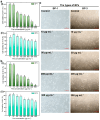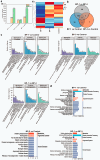Understanding of Benzophenone UV Absorber-Induced Damage and Apoptosis in Human Hepatoma Cells
- PMID: 40243607
- PMCID: PMC11988835
- DOI: 10.3390/ijms26072990
Understanding of Benzophenone UV Absorber-Induced Damage and Apoptosis in Human Hepatoma Cells
Abstract
Benzophenone UV absorbers (BPs), a widely used family of organic UV absorbers (UVAs), have attracted considerable attention for their effects on organisms in recent years. Previous research has been unable to illuminate the intricate situation of BP pollution. To address this knowledge gap, we devised a BAPG-chain model that surpasses existing approaches based on biochemical detection, antioxidant defense systems, proteins, and genes to investigate the biological mechanisms of benzophenone-1 (BP-1) and benzophenone-3 (BP-3) within human hepatoma SMMC-7721 cells as model organisms. The BAPG-chain model links the cellular model, molecular level, macroscopic scale, and microscopic phenomena by adopting a global assessment mindset. Our findings indicate that BPs induce apoptosis via the excessive production of reactive oxygen species (ROS), mitochondrial and nuclear damage, and disruption of the antioxidant stress system. Notably, BPs induce apoptosis via alterations in the expression of genes and proteins associated with apoptosis in the mitochondria. Our experimental evidence sheds light on the biological effects of BPs and highlights the need for further research in this area.
Keywords: BAPG-chain model; benzophenone UV absorbers (BPs); biological mechanism; human hepatoma cells.
Conflict of interest statement
The authors declare no conflicts of interest.
Figures




Similar articles
-
Role of type I & type II reactions in DNA damage and activation of caspase 3 via mitochondrial pathway induced by photosensitized benzophenone.Toxicol Lett. 2015 Jun 1;235(2):84-95. doi: 10.1016/j.toxlet.2015.03.008. Epub 2015 Mar 20. Toxicol Lett. 2015. PMID: 25800561
-
Sunscreen-induced expression and identification of photosensitive marker proteins in human keratinocytes under UV radiation.Toxicol Ind Health. 2019 Jul;35(7):457-465. doi: 10.1177/0748233719862128. Toxicol Ind Health. 2019. PMID: 31364504
-
III-10, a newly synthesized flavonoid, induces cell apoptosis with the involvement of reactive oxygen species-mitochondria pathway in human hepatocellular carcinoma cells.Eur J Pharmacol. 2015 Oct 5;764:353-362. doi: 10.1016/j.ejphar.2015.06.057. Epub 2015 Jul 9. Eur J Pharmacol. 2015. PMID: 26164795
-
Assessment of human exposure to benzophenone-type UV filters: A review.Environ Int. 2022 Sep;167:107405. doi: 10.1016/j.envint.2022.107405. Epub 2022 Jul 11. Environ Int. 2022. PMID: 35843073 Review.
-
[Research progress on the environmental and human exposure of organic ultraviolet absorbers].Zhonghua Yu Fang Yi Xue Za Zhi. 2025 Apr 6;59(4):516-525. doi: 10.3760/cma.j.cn112150-20240715-00570. Zhonghua Yu Fang Yi Xue Za Zhi. 2025. PMID: 40176676 Review. Chinese.
References
-
- Janjua N.R., Mogensen B., Andersson A.-M., Petersen J.H., Henriksen M., Skakkebæk N.E., Wulf H.C. Systemic absorption of the sunscreens benzophenone-3, octyl-methoxycinnamate, and 3-(4-methyl-benzylidene) camphor after whole-body topical application and reproductive hormone levels in humans. J. Investig. Dermatol. 2004;123:57–61. doi: 10.1111/j.0022-202X.2004.22725.x. - DOI - PubMed
-
- Pomierny B., Krzyżanowska W., Broniowska Ż., Strach B., Bystrowska B., Starek-Świechowicz B., Maciejska A., Skórkowska A., Wesołowska J., Walczak M., et al. Benzophenone-3 passes through the blood-brain barrier, increases the level of extracellular glutamate, and induces apoptotic processes in the hippocampus and frontal cortex of rats. Toxicol. Sci. 2019;171:485–500. doi: 10.1093/toxsci/kfz160. - DOI - PubMed
MeSH terms
Substances
Grants and funding
LinkOut - more resources
Full Text Sources
Medical
Miscellaneous

